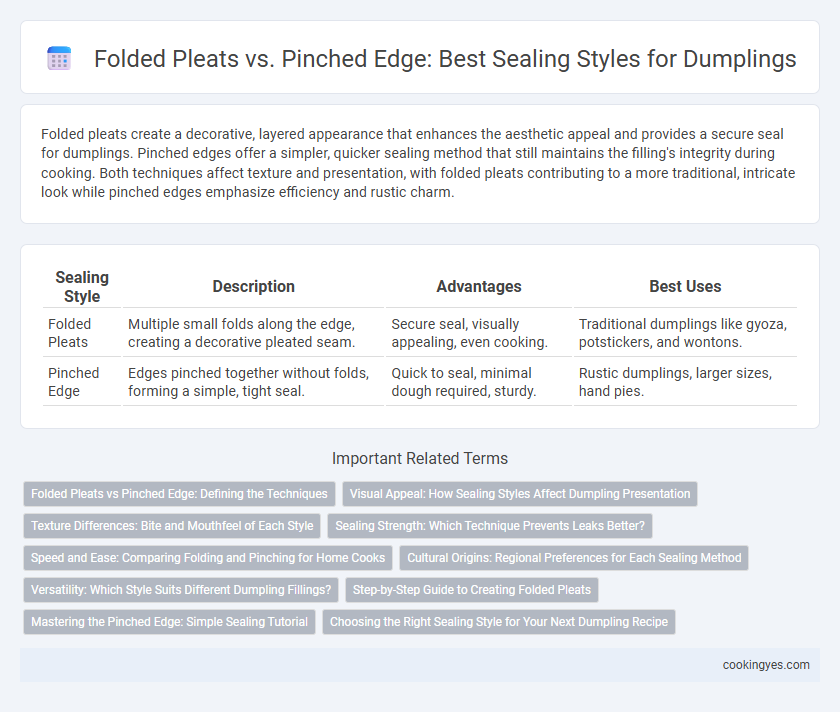Folded pleats create a decorative, layered appearance that enhances the aesthetic appeal and provides a secure seal for dumplings. Pinched edges offer a simpler, quicker sealing method that still maintains the filling's integrity during cooking. Both techniques affect texture and presentation, with folded pleats contributing to a more traditional, intricate look while pinched edges emphasize efficiency and rustic charm.
Table of Comparison
| Sealing Style | Description | Advantages | Best Uses |
|---|---|---|---|
| Folded Pleats | Multiple small folds along the edge, creating a decorative pleated seam. | Secure seal, visually appealing, even cooking. | Traditional dumplings like gyoza, potstickers, and wontons. |
| Pinched Edge | Edges pinched together without folds, forming a simple, tight seal. | Quick to seal, minimal dough required, sturdy. | Rustic dumplings, larger sizes, hand pies. |
Folded Pleats vs Pinched Edge: Defining the Techniques
Folded pleats involve carefully layering dough edges to create multiple, overlapping folds that enhance both texture and visual appeal, often used in traditional Chinese dumplings like jiaozi. Pinched edge sealing, by contrast, requires pressing the dough edges together in a simple, uniform manner, resulting in a stronger, more straightforward seal that prevents filling leakage during cooking. The choice between folded pleats and pinched edge techniques significantly impacts the dumpling's aesthetic, cooking method, and texture.
Visual Appeal: How Sealing Styles Affect Dumpling Presentation
Folded pleats create intricate, symmetrical patterns that enhance the dumpling's visual appeal, making them look artisanal and inviting. Pinched edges, while simpler, convey a rustic charm and a more casual presentation that emphasizes homemade authenticity. The choice of sealing style directly influences the overall aesthetic, shaping diners' first impressions and expectations of texture and flavor.
Texture Differences: Bite and Mouthfeel of Each Style
Folded pleats create a layered texture that adds a slight chewiness to each bite, enhancing the dumpling's body and providing a satisfying mouthfeel. Pinched edges result in a smoother, tighter seal that emphasizes the filling's juiciness while offering a softer, more delicate bite. These sealing styles influence the overall sensory experience by balancing texture contrasts between dough and filling.
Sealing Strength: Which Technique Prevents Leaks Better?
Folded pleats create multiple overlapping layers, enhancing the sealing strength by distributing pressure evenly along the edge, which effectively prevents leaks during cooking. Pinched edges rely on a single fold, making them quicker to seal but more prone to opening under steam or boiling water pressure. For maximum leak prevention, folded pleats provide a more secure and durable seal, especially for juicy or delicate dumpling fillings.
Speed and Ease: Comparing Folding and Pinching for Home Cooks
Folded pleats offer a more structured seal that can be quickly mastered with practice, making them ideal for home cooks seeking consistency and moderate speed. Pinched edges provide the fastest sealing method, requiring less precision and time, perfect for beginners or busy kitchens focused on efficiency. Both methods ensure secure sealing, but pinching outpaces folding in ease and speed during dumpling preparation.
Cultural Origins: Regional Preferences for Each Sealing Method
Folded pleats for sealing dumplings are a hallmark of Chinese culinary tradition, especially prominent in regions like northern China where jiaozi feature intricate pleats symbolizing prosperity. The pinched edge style is more common in Japanese gyoza and Korean mandu, reflecting a minimalist approach that emphasizes speed and practicality in preparation. These regional preferences highlight how cultural heritage influences the aesthetic and functional aspects of dumpling sealing techniques.
Versatility: Which Style Suits Different Dumpling Fillings?
Folded pleats offer a versatile sealing style ideal for juicy or finely minced fillings like pork and cabbage, as the pleats create a sturdy grip that prevents leakage during steaming or boiling. Pinched edges are better suited for firmer or chunkier fillings such as shrimp or vegetable mixtures, providing a quick seal that maintains the dumpling's shape while allowing some expansion. Choosing between folded pleats and pinched edges depends on the filling's texture and moisture content, ensuring optimal cooking results and presentation.
Step-by-Step Guide to Creating Folded Pleats
Creating folded pleats for sealing dumplings involves precise folding techniques that enhance both appearance and texture. Begin by placing a small amount of filling in the center of the wrapper, then fold the edge in half to create a semi-circle; pinch one end to secure, and start making small, uniform pleats along the curved edge, pressing each pleat firmly to seal the dumpling tightly. This method produces an attractive, durable seal that holds up well during cooking, compared to the simpler pinched edge style, which may be less decorative and prone to opening.
Mastering the Pinched Edge: Simple Sealing Tutorial
Mastering the pinched edge sealing style enhances dumpling integrity by creating a tight, pleat-free seal that prevents filling leakage during cooking. This technique involves pressing the dough edge firmly between thumb and forefinger, producing a smooth, consistent closure ideal for delicate fillings. Perfecting this method ensures visually appealing dumplings with a clean finish and reliable structural strength.
Choosing the Right Sealing Style for Your Next Dumpling Recipe
Folded pleats offer a decorative and secure sealing style ideal for dumplings filled with moist ingredients, ensuring the filling stays intact during cooking. Pinched edges provide a simpler, quicker seal best suited for thinner dough and less juicy fillings, allowing for a clean and uniform finish. Selecting the right sealing technique depends on the dumpling dough type, filling moisture content, and desired presentation, optimizing both durability and aesthetics.
Folded pleats vs Pinched edge for sealing style Infographic

 cookingyes.com
cookingyes.com